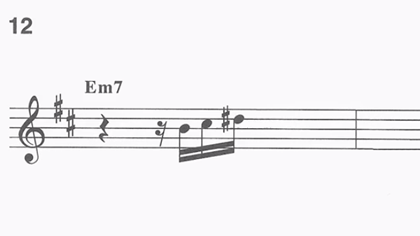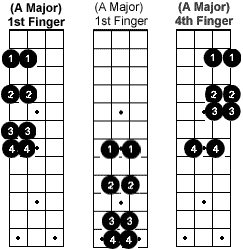« October 2013 |
Main
| December 2013 »
 November 28, 2013 | Twelve Benefits of Music Education
November 28, 2013 | Twelve Benefits of Music Education
Much has been written about the physical and spiritual benefits of music for children. We don't think these stop at childhood, either. Below are 12 points to consider what participating in music does for the brain, coordination in addition to cultural and social benefits.
Twelve Benefits of Music Education
Carolyn Phillips
Early musical training helps develop brain areas involved in language and reasoning. It is thought that brain development continues for many years after birth. Recent studies have clearly indicated that musical training physically develops the part of the left side of the brain known to be involved with processing language, and can actually wire the brain's circuits in specific ways. Linking familiar songs to new information can also help imprint information on young minds.
 There is also a causal link between music and spatial intelligence (the ability to perceive the world accurately and to form mental pictures of things). This kind of intelligence, by which one can visualize various elements that should go together, is critical to the sort of thinking necessary for everything from solving advanced mathematics problems to being able to pack a book-bag with everything that will be needed for the day. There is also a causal link between music and spatial intelligence (the ability to perceive the world accurately and to form mental pictures of things). This kind of intelligence, by which one can visualize various elements that should go together, is critical to the sort of thinking necessary for everything from solving advanced mathematics problems to being able to pack a book-bag with everything that will be needed for the day.
Students of the arts learn to think creatively and to solve problems by imagining various solutions, rejecting outdated rules and assumptions. Questions about the arts do not have only one right answer.
Recent studies show that students who study the arts are more successful on standardized tests such as the SAT. They also achieve higher grades in high school.
A study of the arts provides children with an internal glimpse of other cultures and teaches them to be empathetic towards the people of these cultures. This development of compassion and empathy, as opposed to development of greed and a "me first" attitude, provides a bridge across cultural chasms that leads to respect of other races at an early age.
Students of music learn craftsmanship as they study how details are put together painstakingly and what constitutes good, as opposed to mediocre, work. These standards, when applied to a student's own work, demand a new level of excellence and require students to stretch their inner resources.
In music, a mistake is a mistake; the instrument is in tune or not, the notes are well played or not, the entrance is made or not. It is only by much hard work that a successful performance is possible. Through music study, students learn the value of sustained effort to achieve excellence and the concrete rewards of hard work.
Music study enhances teamwork skills and discipline. In order for an orchestra to sound good, all players must work together harmoniously towards a single goal, the performance, and must commit to learning music, attending rehearsals, and practicing.
Music provides children with a means of self-expression. Now that there is relative security in the basics of existence, the challenge is to make life meaningful and to reach for a higher stage of development. Everyone needs to be in touch at some time in his life with his core, with what he is and what he feels. Self-esteem is a by-product of this self-expression.
Music study develops skills that are necessary in the workplace. It focuses on "doing," as opposed to observing, and teaches students how to perform, literally, anywhere in the world. Employers are looking for multi-dimensional workers with the sort of flexible and supple intellects that music education helps to create as described above. In the music classroom, students can also learn to better communicate and cooperate with one another.
Music performance teaches young people to conquer fear and to take risks. A little anxiety is a good thing, and something that will occur often in life. Dealing with it early and often makes it less of a problem later. Risk-taking is essential if a child is to fully develop his or her potential.
An arts education exposes children to the incomparable.
Carolyn Phillips is the author of the Twelve Benefits of Music Education. She is the Former Executive Director of the Norwalk Youth Symphony, CT.
Posted by Ted at 8:10 AM
 November 21, 2013 | Words from Will Patton
November 21, 2013 | Words from Will Patton
In April of 2011, we had the privilege of interviewing Vermont acoustic jazz string master Will Patton in the Mandolin Cafe online Ten Questions series.
Question: A mandolin fronting a jazz ensemble is a bit of a rarity. What barriers do you see in public perception of the mandolin as a legitimate jazz instrument, and how do you/we get over them?
Will Patton: Great question, one I've given a bit of thought to. First off, I've found that context again is important. The mandolin as a lead instrument is just going to sound better surrounded by violins, flutes, guitars, string bass and the like than by trombones, trumpets, sax, Hammond B-3 - it's just in the nature of the timbre. I once sat in on a blues with a happening jazz group, played what I felt was a cooking solo, but when the tenor player came in with this big, rich tone out of the Coleman Hawkins school, I felt a bit silly. Not my context.
Secondly, I think if most large cities had 8-10 mandolin players who knew 200 standards off book, could read and transpose, solo convincingly in any key and lay out changes behind other soloists, the perception of jazz mandolin would be some different. We expect this of jazz guitarists, but it's the exception for a mandolin player.
Read entire interview: 10 Questions for Will Patton

Further:
Cafe Interviews
Tips on improvising from the Pros; Will Patton
Looking back: What the Pros say about Good Tone
Lydian spice
Will Patton on Amazon

Posted by Ted at 6:27 AM
 November 14, 2013 | Animated Sheet Music; So What
November 14, 2013 | Animated Sheet Music; So What
There's nothing like reinforcing the sense of hearing with that of sight. Sometimes we can take advantage of the visual cue to prompt creativity, as long as we don't let ourselves get trapped by them. We don't want to be a slave to sheet music, but there is something to be said about the benefit of roadmaps.

We've enjoyed studying some of the Animated Sheet Music YouTube videos for their insights into some of the classic Bebop performances of Charlie Parker and Miles Davis. We've embedded one below for you to sit back and enjoy. Sometimes seeing how Miles Davis worked around an Em7 chord is as helpful a just listening to it.
Video Link: Animated Sheet Music: "So What" by Miles Davis
Get sheet music: Miles Davis - Kind of Blue
Further
Minor 7th chord streams. So What?
Minor 7th Chord Streams. Under the hood.
Vamps. Minor modal
Advanced Pentatonic
The Muse Continuum. Improvisation and Inspiration.
Posted by Ted at 4:51 PM
 November 7, 2013 | Best of JM: Octave Splicing
November 7, 2013 | Best of JM: Octave Splicing
Enjoy the popular archive material below.
From October 9, 2008 | Octave Splicing
The beauty of the 5ths tuned instruments is pattern movability. That's a constant theme in our frequent FFcP nuggets and offerings--learn a riff, scale segment, or arpeggio in one place, you can copy it to another string or fret in a different region of the fretboard.

There are two ways to do this. One is to completely move everything using the same exact fingering, the other is to start the pattern with a different finger, maintain the same note relationships but use a different incarnation of the four FFcP patterns. It's obvious in the A scale we've shown above, and could approach an A Maj7 arpeggio or A blues riff repeated in a second octave, as well.
After getting familiar with FFcP, you might start getting a little too comfortable staying in the same section of the fretboard. It's a good idea to move around though, taking the next step of adjusting known patterns above the 7th fret where the spacings are closer, and less familiar in feel. You'll also want to be able to connect these nuggets in a smooth way and start thinking how you can extend your playing across the fretboard, and not just across the strings. Starting a two octave riff on the 2nd fret and ending it on the 11th is not a natural skill, and something to nurture and develop over time.

The toughest thing to do in the transition is making the shift in hand position seamless. The simplest way to start is with major scales, but you can do this with pentatonics and 7th chord arpeggios too. Focus very hard on that shift, making it as natural as you can.
Two benefits you get from this, an even deeper mental and tactile understanding of how notes and their functions stack up all over the neck, and the ability to extend a solo phrase into a 2nd or even 3rd octave... Fearlessly!
Try splicing your own octave patterns into two octave patterns in your practice regimen.
Further:
Moving Horizontally
Patterns Overboard.
Leading Off Third Base: The benefits of third position fingering.
Moving on up. And around.
Enjoy 2 Page PDF:  Moving on Up Moving on Up
Posted by Ted at 6:15 PM

Disclaimer: In the 'Information Age' of the 21st Century,
any fool with a computer, a modem, and an idea can
become a self-professed 'expert." This site does not
come equipped with 'discernment.'
|



